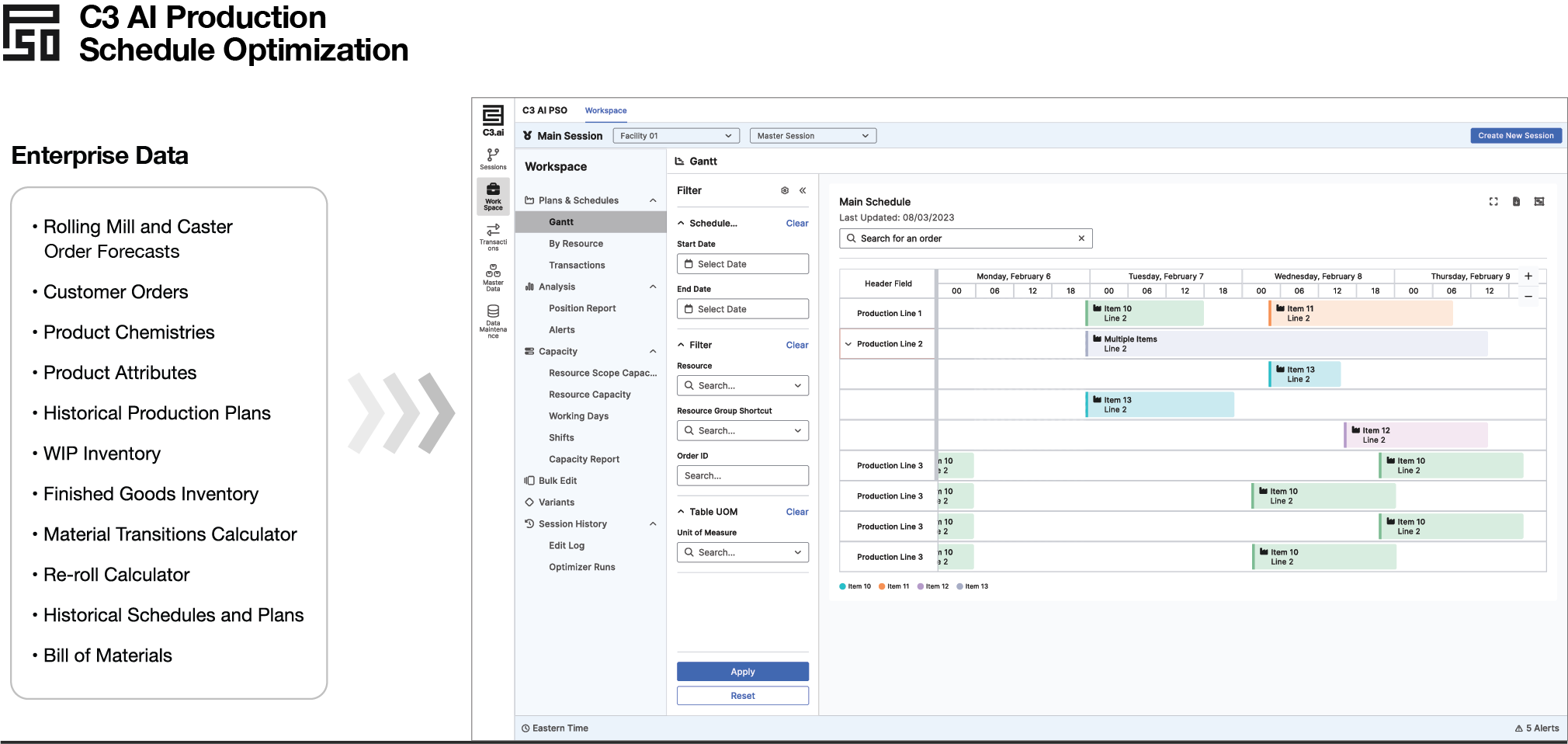Large Steel Manufacturer Improves Production Efficiency with Advanced AI
Challenges
This national steel manufacturer operates a large steel mill that manufactures over 400 distinct steel products across seven cast sizes. This continuous manufacturing process runs in two-week production cycles. Planning and scheduling the caster was a time-intensive process that was created by subject matter experts with decades of experience. This resulted in sub-optimal production schedules that were rigid, took up to 5 days to develop, and produced excess inventory while not fully meeting customer demand.
The current production planners and schedulers relied on disjointed information from seven data sources across five distinct source systems to make planning and scheduling decisions. Planners attempted to identify opportunities to reuse existing inventory to meet demand. Schedulers then took the resulting demand for the caster and sequenced the production to meet as much of the demand as possible while limiting scrap production. The company previously used manual spreadsheets to address scheduling challenges. However, the following challenges had continued to impact their ability to generate production plans and schedules:
- Multiple production factors and constraints were not codified in enterprise systems,
making it difficult to reliably utilize all relevant information to plan and schedule the caster. This included transition rules and yield calculations that drive production decision making. - Variable customer demand required frequent updates in product schedules to fulfill orders while preventing excessive inventory.
- Creating scenarios to review different production scheduling options was manual and time-intensive, making it difficult to respond to new orders, production outages, and changing raw material inventories.
Approach
Over 26 weeks, C3 AI configured the C3 AI Production Schedule Optimization application for a $1 billion steel mill for caster steel production for bar steel. The team began by ingesting, cleansing, and unifying three years of historical steel data from seven source systems. This unified federated data image, which stores product details, inventory levels, steel chemistries, and order data, enabled the company to deploy and operate the C3 AI Production Schedule Optimization application on up-to-date data pulled from all relevant sources. It also formed the foundation for addressing additional AI use cases in manufacturing including demand forecasting and inventory optimization.
In the project, an AI optimization algorithm was created to increase net production within the caster. The optimizer considered over 300 distinct variables and constraints impacting the production process. The optimizer efficiently allocated production to minimize lost materials from production by altering the sequence of production while balancing product, process, and supply chain details. The team tested the optimizer results across 46 historical cycle schedules and was able to meet or exceed generated schedules by subject matter experts in all cases. When evaluated over one year’s results, the optimizer was able to improve net production by ~1%, resulting in 1,000+ tons of additional finished product that could have been sold to customers. This results in a $1 million benefits for the steel mill with the potential to generate up to $4 million when expanding to 3 steel mills.
Finally, the joint team configured a multi-screen user interface to plan and schedule caster production. Live data connections were established to support ongoing scheduling work. The workflowdriven user interface enables planners and schedulers to visualize optimization results and to create scenarios. The application reduces the time to plan and schedule a cycle from 5-7 days to 1 hour, driving operational efficiencies.
About the Company
- $35+ billion annual revenue in 2023
- 35+ million tons of steel produced
- 30+ steel mills
- 30,000 employees
Project Objectives
- Integrate and unify data from seven disparate data sources into a unified federated data image.
- Apply optimization algorithms to maximize net production for a manufacturing cycle.
- Configure the C3 AI Production Schedule Optimization user interface to deliver AI insights to end users in a user-friendly interface.
Project Highlights
- 26 weeks from kick-off to production-ready application
- Unified three years of historical data from seven data sources
- Codified specific production factors, processes, and constraints of the steel mill into the application
- Built extensive AI optimization models with 300 variables and constraints
- Configured and tested the AI optimization models to increase net production within the caster
- Configured a workflow-enabled interface to allow dynamic responses to drop-in orders
Results
Solution Architecture

